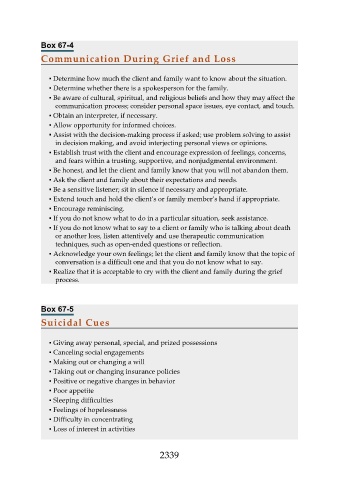Page 2339 - Saunders Comprehensive Review For NCLEX-RN
P. 2339
Box 67-4
Communication During Grief and Loss
▪ Determine how much the client and family want to know about the situation.
▪ Determine whether there is a spokesperson for the family.
▪ Be aware of cultural, spiritual, and religious beliefs and how they may affect the
communication process; consider personal space issues, eye contact, and touch.
▪ Obtain an interpreter, if necessary.
▪ Allow opportunity for informed choices.
▪ Assist with the decision-making process if asked; use problem solving to assist
in decision making, and avoid interjecting personal views or opinions.
▪ Establish trust with the client and encourage expression of feelings, concerns,
and fears within a trusting, supportive, and nonjudgmental environment.
▪ Be honest, and let the client and family know that you will not abandon them.
▪ Ask the client and family about their expectations and needs.
▪ Be a sensitive listener; sit in silence if necessary and appropriate.
▪ Extend touch and hold the client’s or family member’s hand if appropriate.
▪ Encourage reminiscing.
▪ If you do not know what to do in a particular situation, seek assistance.
▪ If you do not know what to say to a client or family who is talking about death
or another loss, listen attentively and use therapeutic communication
techniques, such as open-ended questions or reflection.
▪ Acknowledge your own feelings; let the client and family know that the topic of
conversation is a difficult one and that you do not know what to say.
▪ Realize that it is acceptable to cry with the client and family during the grief
process.
Box 67-5
Suicidal Cues
▪ Giving away personal, special, and prized possessions
▪ Canceling social engagements
▪ Making out or changing a will
▪ Taking out or changing insurance policies
▪ Positive or negative changes in behavior
▪ Poor appetite
▪ Sleeping difficulties
▪ Feelings of hopelessness
▪ Difficulty in concentrating
▪ Loss of interest in activities
2339

